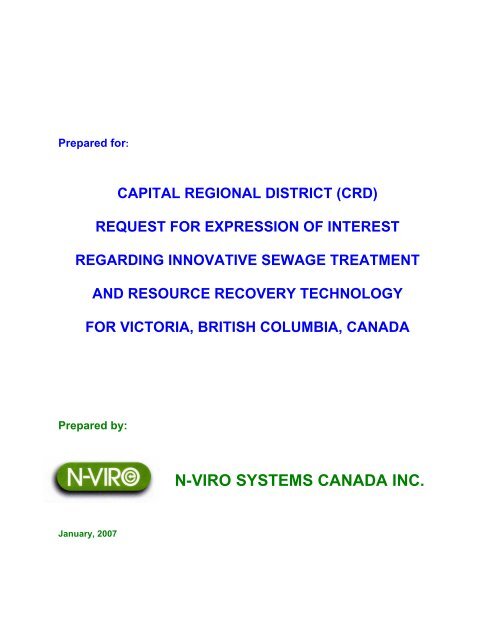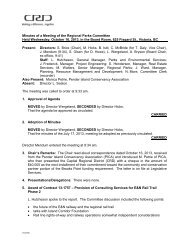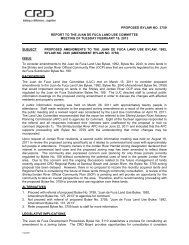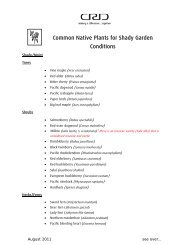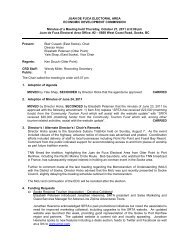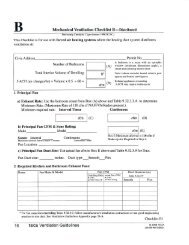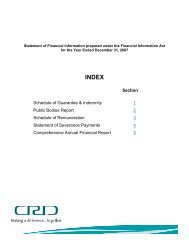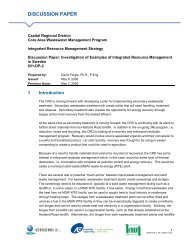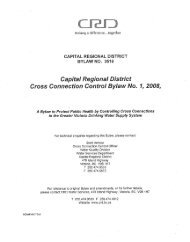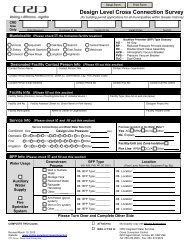N-VIRO SYSTEMS CANADA INC. - Capital Regional District
N-VIRO SYSTEMS CANADA INC. - Capital Regional District
N-VIRO SYSTEMS CANADA INC. - Capital Regional District
You also want an ePaper? Increase the reach of your titles
YUMPU automatically turns print PDFs into web optimized ePapers that Google loves.
Prepared for:<br />
CAPITAL REGIONAL DISTRICT (CRD)<br />
REQUEST FOR EXPRESSION OF INTEREST<br />
REGARDING INNOVATIVE SEWAGE TREATMENT<br />
AND RESOURCE RECOVERY TECHNOLOGY<br />
FOR VICTORIA, BRITISH COLUMBIA, <strong>CANADA</strong><br />
Prepared by:<br />
January, 2007<br />
N-<strong>VIRO</strong> <strong>SYSTEMS</strong> <strong>CANADA</strong> <strong>INC</strong>.
Table of Contents<br />
Section<br />
1. Company Information & Authorized Officers<br />
2. Description of Technology<br />
3. Overview of Canadian Plants<br />
4. Non-Canadian Plants<br />
5. Demonstrated Operating Abilities<br />
6. Demonstrated Marketing Abilities<br />
7. Product Uses, Approvals, Properties<br />
8. Project Example<br />
Appendix
1 Company Information & Authorized Officers<br />
N-Viro Systems Canada Inc.<br />
Rae Wallin<br />
President, N-Viro Systems Canada Inc.<br />
Corporate Head Office<br />
1307 Highway 2 East<br />
P.O. Box 280<br />
Maitland, Ontario<br />
K0E 1P0<br />
Tel.: (613) 348-3302<br />
Fax: (613) 348-1050<br />
Email: rwallin@sympatico.ca<br />
Grant Mills<br />
Vice President, N-Viro Systems Canada Inc.<br />
746 Hurondale Drive<br />
Mississauga, Ontario<br />
L5C 4N9<br />
Tel.: (905) 566-9464<br />
Fax: (905) 566-4558<br />
Email: grant.mills@sympatico.ca<br />
Burns Stephen<br />
Vice President, Product Marketing<br />
48 Lyndhurst Avenue<br />
R. R. #1<br />
Simcoe, Ontario<br />
N3Y 4J9<br />
Tel.: (519) 410-3228<br />
Fax: (519) 582-4364<br />
Email: bstephen@kwic.com
2 Description of the Technology<br />
“The N-Viro process<br />
takes all the headaches<br />
away”.<br />
Dan Rabe,<br />
Biosolids Supervisor<br />
Auburn, IN<br />
N-Viro Systems Canada Inc. proposes the N-Viro Soil process, which is a<br />
patented process for the treatment and recycling of bio-organic wastes,<br />
utilizing certain alkaline byproducts. To date, the N-Viro process has been<br />
commercially utilized for the recycling of sludges from municipal<br />
wastewater treatment facilities in the US, the UK, Australia and Canada.<br />
The N-Viro Soil process stabilizes and pasteurizes the wastewater sludge (in<br />
which harmful bacteria are destroyed and the beneficial soil bacteria, or<br />
microflora, survive). It reduces odours to acceptable levels, neutralizes or<br />
immobilizes heavy metals, and generates a product that has a granular<br />
appearance similar to soil. It offers multiple commercial uses.<br />
The Process<br />
General<br />
In the N-Viro Soil patented process (Advanced Alkaline Stabilization with<br />
Subsequent Accelerated Drying, or AASSAD), an alkaline admixture (AA)<br />
is added to dewatered sludge, mixed, heated (in part through a chemical<br />
reaction) and dried.<br />
A flow diagram of the typical N-Viro soil process and a description of the<br />
process unit steps are shown on the N-Viro Advanced Alkaline Stabilization<br />
Technology - Process Schematic, page 4.<br />
Material<br />
The N-Viro process uses mechanically dewatered sludge, called sludge cake,<br />
which consists of between 16 and 35 percent solids. The process can accept a<br />
variety of sludges: primary, primary/waste activated or waste activated,<br />
either digested or undigested.<br />
The dewatered cake is either transported by truck to a dedicated N-Viro Soil<br />
facility or mechanically conveyed to an N-Viro facility integrated with a<br />
wastewater treatment plant.<br />
Mixing<br />
Alkaline admixtures (AA), usually industrial by-products such as cementkiln<br />
dust, lime-kiln dust, fly ash and/or steel-making fines supplemented in<br />
some cases with quicklime, are mixed with the dewatered sludge cake. The<br />
admixtures are dosed at a rate of 30 to 45 percent of the wet-weight sludge.<br />
The amount of the alkaline admixture varies according to the amount of<br />
heating required or desired in the processing, the type of sludge (the higher<br />
the solids content the lower the AA dosage), the characteristics of the<br />
alkaline admixture, and the intended beneficial reuse market(s). If the<br />
2
Advantages of BioDry<br />
Rotary Drum Dryer<br />
Technology<br />
∠ improved biosolids drying<br />
efficiency<br />
∠ advanced process automation<br />
∠ single-pass materials handling<br />
∠ reduction in biosolids product<br />
∠ complete emission control<br />
∠ consistent high quality product<br />
∠ limited footprint requirements<br />
∠ elimination of special product<br />
storage requirements<br />
admixture does not contain enough free lime (CaO, Ca(OH)2 or other strong<br />
alkali) to give the necessary temperature and pH rise, CaO is added.<br />
Blending takes place in a pug-mill-type mixer.<br />
Drying<br />
Following the mixing step the product is dried to the desirable 60 - 65<br />
percent solids content with the use of a mechanical rotary-drum dryer. All of<br />
the proposals put forward by N-Viro Canada incorporate mechanical drying.<br />
The mixer discharge goes directly to a single-pass, rotary-drum dryer. The<br />
dryer discharge then goes to a “heat-pulse” cell. A combination of heat from<br />
the dryer and a chemical reaction between the alkaline materials and the<br />
moisture in the sludge cake raises the temperature to a controlled range of<br />
between 52 and 62°C and the pH to slightly above 12. The material is held in<br />
the heat-pulse cell(s) in the controlled temperature range for a period of 12<br />
hours. The elevated pH is maintained for a total of 72 hours, after which the<br />
product is ready for distribution or storage.<br />
N-Viro Facility and Process Schematic<br />
3
Stability and Pathogen Reduction<br />
The basis of the N-Viro Soil process is to destroy pathogens through a<br />
combination of stresses:<br />
1. alkaline pH<br />
2. high temperature<br />
3. high ammonia<br />
4. accelerated drying<br />
5. indigenous microflora<br />
The pathogen destroying stresses are produced in the sludge/alkaline<br />
admixture through the unique properties of the admixture. The high<br />
alkalinity contributes to stresses 1, 2 and 3 with extremely fine particle size<br />
and low moisture content contributing to stress 4. As with compost,<br />
thermophilic temperatures (52 - 62°C) and a soil-like environment contribute<br />
to the growth of indigenous microorganisms that suppress the regrowth of<br />
pathogens and putrefying organisms (stress 5). The relatively high population<br />
of soil organisms in the final product (10 3 to 10 7 per gram) produces a slow<br />
composting in the material in which degradable organics from the sludge are<br />
stabilized.<br />
Odour Control<br />
Another important feature of the N-Viro Soil process in producing a<br />
marketable, sludge-derived product is odour control. A Venturi scrubber is<br />
used for particulate removal followed by an acid scrubber (as necessary), and<br />
then by a biofilter. Air from the mixer area, the heat-pulse, the product<br />
storage area and the exhaust from the dryer are all treated.<br />
The primary emissions are particulates, ammonia, and trimethylamines,<br />
which are released during the drying and heat-pulse phases. They are<br />
amenable to scrubbing, such that emissions readily meet regulatory<br />
requirements.<br />
The design of the odour control system at the N-Viro Facility will meet the<br />
following criteria:<br />
• fully and effectively enclose the facility, including the product<br />
storage area<br />
• maintain all process and storage areas under negative pressure<br />
• treat all malodourous air prior to discharge.<br />
Noise control<br />
Noise control at the N-Viro Facility is achieved by the following proposed<br />
measures:<br />
• facility is enclosed<br />
• all equipment installed in the facility is required to meet guidelines<br />
for acceptable noise emission levels.<br />
5
Dust control<br />
Dust control at the N-Viro Facility is achieved by the following proposed<br />
measures:<br />
• facility is enclosed and under negative pressure<br />
• all process and dryer exhaust air is exhausted through the emissions control<br />
system, which consists of Venturi scrubber, followed by an acid scrubber,<br />
followed by a biofilter<br />
• all air discharged from the facility is directed through the biofilter.<br />
The product<br />
The N-Viro Soil product meets the requirements of applicable Agriculture<br />
and Agri-Food Canada (Ag Canada) Fertilizers Act and Regulations, and<br />
Provincial guidelines for its use in the agricultural sectors. A product label,<br />
approved by the CFIA, is obtained for each facility.<br />
The N-Viro Soil process also meets the current US EPA Regulation 40 CFR<br />
503 and is classed as Exceptional Quality Sludge (EQS) or Class A.<br />
The heavy metals present in the sludge are converted to insoluble forms so<br />
the use of N-Viro Soil does not create any adverse conditions in terms of<br />
metals leaching. No hazardous compounds are produced during the process.<br />
Particulate and odour-producing substances are collected and removed via a<br />
multi-stage scrubbing system.<br />
The final product is a biologically stable, low-odour, safe, soil-like material<br />
that will have a solids content of approximately 62 percent.<br />
Sustainable Development Technology<br />
Principles of sustainable development include:<br />
• fulfillment of human needs for clean air and water<br />
• maintenance of ecological integrity through reduction in wastes and<br />
protection of diverse and important natural systems<br />
• provision for self-determination through public involvement in the<br />
definition and development of local solutions to environmental problems<br />
• achievement of equity with the fairest possible sharing of limited<br />
resources.<br />
The N-Viro technology is a process that meets the requirements of<br />
sustainable development with beneficial reuse applications in agriculture,<br />
land reclamation, horticulture and landfill areas.<br />
In response to the principles of sustainable development noted above:<br />
1. N-Viro utilizes two waste products, cement kiln dust, or like byproducts,<br />
and sewage sludge, to produce N-Viro Soil, a granular soil-like<br />
product that has many beneficial reuse markets.<br />
6
2. N-Viro Soil provides valuable nutrients such as nitrogen, phosphorous,<br />
potassium, aglime equivalency and organics that when applied to<br />
agricultural land or used for horticultural purposes, reduces the use of<br />
chemical fertilizers and improves soil characteristics.<br />
3. N-Viro Soil meets the Provincial guidelines for agricultural land<br />
application, as well as those of the Ag Canada Fertilizers Act and<br />
Regulations.<br />
4. N-Viro believes in community consultation with respect to the process<br />
and beneficial reuse technology to ensure the public is educated and<br />
supportive.<br />
5 N-Viro is a simple, environmentally friendly technology that is very<br />
efficient in the use of valuable capital and energy resources while<br />
converting sewage sludge waste to product applications that in every<br />
way help to maintain and restore land for healthy productive purposes.
3 Canadian Plant Overview<br />
In Canada, N-Viro facilities are operating in Leamington and Sarnia. These<br />
are certified biosolids management facilities and the products are approved<br />
for use as a soil amendment by the Canadian Food Inspection Agency under<br />
the Federal Fertilizers Act and Regulations.<br />
A summary of the Canadian facilities, together with a list of other projects<br />
under development in Canada, is provided below.<br />
Leamington, Ontario<br />
Location:<br />
The plant is located on the Leamington Pollution Control Centre property. It<br />
serves an equivalent population of approximately 75,000 (18,000 town<br />
population plus the Heinz Food processing facility) in Leamington.<br />
Approximately 70% of the biosolids processed are from Heinz. The plant<br />
has operated continuously since January, 1996.<br />
Contract<br />
The Town of Leamington and N-Viro Systems Canada Inc. (NSCI) comanage<br />
the plant. NSCI provides technical back-up, product approvals,<br />
QA/QC, marketing and distribution of the product under a 15 year operating<br />
contract. The product is distributed under the Federal Fertilizers Act as a soil<br />
amendment to agriculture.<br />
WWTP<br />
The Town of Leamington and Heinz flows are jointly processed through a<br />
common plant (extended aeration process) for approximately 10 months of<br />
the year. During tomato processing (Aug. 15 – Oct. 15) a second, similar<br />
plant dedicated to Heinz wastes is placed in service. There are no digesters.<br />
The biosolids (100% waste activated) are dewatered through centrifuges to<br />
18-22% solids.<br />
Product<br />
Approximately 12,000 product tonnes are produced each year. The product<br />
is marketed through a local fertilizer distributor. The distributor picks up the<br />
product from storage as required, sells and applies it for the farmers.<br />
Sarnia, Ontario<br />
Location<br />
The plant is located on the Sarnia Wastewater Treatment Plant property. The<br />
served population is approximately 75,000 for the City of Sarnia. The plant<br />
has been operating continuously since March, 2001.<br />
8
Contract<br />
NSCI managed the plant using Sarnia Wastewater Treatment Plant operators<br />
for the first 5 years. Upon retirement of the NSCI site manager, we now use<br />
a Sarnia City employee manager along with NSCI support. NSCI also<br />
provides technical back-up, QA/QC, product approvals, marketing and<br />
distribution of the product. A further 5 year contract renewal was signed in<br />
late 2006. The product is distributed under the Federal Fertilizers Act as a<br />
soil amendment to agriculture.<br />
WWTP<br />
The Wastewater Treatment Plant process provides conventional secondary<br />
treatment. There were digesters prior to 2001 which were shut down when<br />
the N-Viro process took over. The biosolids combined are dewatered<br />
through centrifuges to 26-30% solids.<br />
Product<br />
Approximately 7,000 product tonnes are produced each year. The product is<br />
marketed through a local fertilizer distributor similar to Leamington.<br />
Niagara Region<br />
Location<br />
The plant is located on private property in Thorold, Ontario. It is located on<br />
a site which has a quarry, landfill, and a composting operation owned and<br />
operated by Walker Industries. It will serve a population of approximately<br />
400,000 (all of the communities in Niagara Region). The plant begins<br />
operation February 1, 2007.<br />
Contract<br />
NSCI and Walker Industries formed a 50/50 Joint Venture called Niagara<br />
Biosolids Corporation (NBC). NBC owns the contract with Niagara Region<br />
and owns the facility. This project received a P 3 award from the Canadian<br />
Council for Public and Private Partnership in 2006. NBC will be jointly<br />
managed by Walker Industries and NSCI. NSCI will also do marketing and<br />
distribution of the product. The product will partly be distributed under the<br />
Federal Fertilizers Act to agriculture and partly for topsoil manufacturing.<br />
This plant has spare capacity and can easily be expanded further to act as a<br />
merchant facility to process other municipalities’ biosolids.<br />
WWTP<br />
Niagara Region operates 8 wastewater treatment plants. All plants are<br />
conventional treatment with digesters. The Region is considering shutting<br />
down some digesters in the future.<br />
The Region’s biosolids will be dewatered through 2 regional dewatering<br />
facilities by centrifuges. The dewatered cake at 26-35% solids will be<br />
trucked to the NBC plant for processing.<br />
9
Product<br />
This plant will produce 40,000 and up to 80,000 tonnes of product per year.<br />
The product will partly be marketed to agriculture and partly to horticulture,<br />
soil blending and possible bagging in the future.<br />
Halifax Region<br />
History at Halifax Wastewater Treatment Plants<br />
The Halifax <strong>Regional</strong> Municipality (HRM) has had very limited wastewater<br />
treatment up until now. The bulk of the sewage was discharged directly into<br />
Halifax Harbour. A $330 million project was started several years ago to:<br />
1. Provide a collection sewer system<br />
2. Build 3 new wastewater treatment plants to serve Halifax City,<br />
Dartmouth and Herring Cove.<br />
3. Build a biosolids processing facility (BPF).<br />
An existing wastewater treatment plant at the Halifax Aerotech industrial<br />
park services the airport, septage haulers and biosolids from several small<br />
wastewater treatment plants.<br />
The Halifax Region will own all of the facilities with contract operations for<br />
the biosolids processing facility.<br />
Location<br />
The biosolids processing facility (BPF) will be located in the industrial park<br />
at the airport (Aerotech Park). Biosolids from the three new wastewater<br />
treatment plants and the existing Aerotech plant will be trucked to the BPF.<br />
The BPF will serve a population of approximately 400,000.<br />
Contract<br />
Hatch Engineering, under a design-build contract, built the BPF for HRM.<br />
NSCI have an operating contract for complete operations of the BPF plus<br />
approvals, marketing and distribution of the product. This is a 5 year<br />
contract with 5 year renewals.<br />
WWTPs<br />
The three new wastewater treatment plants will all be enhanced primary<br />
treatment. Due to the N-Viro process, digestion was not necessary for<br />
beneficial reuse of the biosolids-based product. This facilitated a much<br />
lower cost wastewater treatment plant process. The existing Aerotech Park<br />
wastewater treatment plant will provide a mixture of untreated septage,<br />
digested and undigested sludges.<br />
Dewatering at all wastewater treatment plants will be by Fournier Presses<br />
providing dewatered cake at 28-38% solids.<br />
10
Product<br />
Approximately 35,000 tonnes of product at full production per year will be<br />
produced. It is planned for 60% to go to agriculture through local<br />
distributors. The balance of 40% will be used for topsoil manufacture, sod<br />
growing, horticulture and as a back-up, some land reclamation.<br />
Summerside, PEI<br />
Location<br />
The plant is under construction on the Summerside Wastewater Treatment<br />
Plant site. This will be a small plant serving a population equivalent of<br />
approximately 40,000 (12,000 town population and a dairy products’<br />
operation).<br />
Contract<br />
NSCI will provide technical support, approvals, marketing and distribution<br />
under a service contract. The product will be distributed under the Canadian<br />
Fertilizers Act.<br />
WWTP<br />
The City of Summerside is rebuilding their wastewater treatment plant. The<br />
process will be conventional primary/secondary treatment. Dewatering by<br />
Fournier Press to 30% solids will be in the biosolids building.<br />
Product<br />
Approximately 4,000 tonnes of product will be produced and sold through a<br />
local fertilizer distributor.<br />
11
4 Non-Canadian Locations<br />
There are approximately 50 N-Viro facilities worldwide, serving some 65<br />
communities. They range in size up to 50,000 dry tons per year. The<br />
following are selected N-Viro facilities operating in U.S.<br />
Middlesex, New Jersey<br />
Middlesex is the largest facility using the N-Viro Soil process. It processes<br />
53,000 dry tons per year at a rate of 180 dry tons per day, producing<br />
approximately 180,000 tons per year of N-Viro product. A nearby<br />
wastewater treatment plant, which produces the sludge, has a capacity of 117<br />
million Imperial gallons per day and serves a population of over 1,000,000.<br />
The N-Viro facility went into operation in April 1992 and has been in<br />
continuous operation since.<br />
The Middlesex facility incorporates the basic N-Viro Soil process but<br />
accelerated drying is done by windrowing rather than by the use of a<br />
mechanical dryer. Chemical scrubbers provide odour control.<br />
Your contact for the Middlesex facility is Dan Tanzi at (732) 721-3800.<br />
Syracuse, New York<br />
Sludge capacity: 11,000 dry tons/year<br />
Product Produced: approx. 45,000 tons/year<br />
Contact: Randy Ott, Tel.: (315) 435-6820<br />
Toledo, Ohio<br />
Sludge capacity: 12,000 dry tons/year<br />
Product Produced: 50,000 tons/year<br />
Contact: Randy Hoffman, Tel.: (419) 729-5710<br />
Ashville, North Carolina<br />
Sludge capacity: 6,000 dry tons/year<br />
Product Produced: 30,000 tons/year<br />
Contact: John Kiviniemi, Tel.: (828) 252-7342<br />
12
Greenville, South Carolina<br />
Sludge capacity: 5,000 dry tons/year<br />
Product Produced: 22,000 tons/year<br />
Contact: Joey Collins, Tel.: (864) 299-4714<br />
Wilmington, Delaware<br />
Sludge capacity: 20,000 dry tons/year<br />
Product Produced: 70,000 tons/year<br />
Contact: Bob Jones, Tel.: (610) 918-1100<br />
Daytona Beach, Florida<br />
Sludge capacity: 8,000 dry tons/year<br />
Product Produced: 47,000 tons/year<br />
Contact: Tom Otermat, Tel.: (904) 253-7721<br />
For additional N-Viro facilities we invite you to refer to www.nviro.com.<br />
13
5 Demonstrated Operating Abilities<br />
Operation of N-Viro Facility<br />
N-Viro Systems Canada Inc., has 17 combined years’ operating experience<br />
with its two existing facilities (Sarnia and Leamington), which are similar to<br />
the one put forward in this EOI/Q. N-Viro has the capability to draw on and<br />
provide advice on the experience gained in the operation of some 50 facilities<br />
worldwide over the last 18 years.<br />
N-Viro Canada follows a rigid, daily, quality assurance and quality control<br />
program and a quarterly product analysis regimen at accredited laboratories.<br />
In no case has a product been out of compliance with Ag Canada, the<br />
provincial guidelines or with the US EPA regulations 40 CFR 503 that<br />
embodies the Class A designation.<br />
N-Viro developed a QA/QC Monitoring Protocol for its facilities, which<br />
would also be implemented in the CRD Biosolids Processing Facility. The<br />
protocol is detailed on the following page.<br />
14
QA/QC MONITORING PROTOCOL FOR<br />
CRD BIOSOLIDS PROCESSING FACILITY<br />
I. Dewatered sludge cake: evaluation to determine the characteristics of the material going into the N-Viro System:<br />
Metals:<br />
Eleven trace metals regulated by Provincial and Federal authorities: Arsenic, Cadmium, Chromium, Cobalt,<br />
Copper, Lead, Mercury, Molybdenum, Nickel, Selenium and Zinc.<br />
Information obtained from CRD sewage treatment plants will be used as the baseline information as well as<br />
regular monitoring for this portion of the protocol.<br />
II. Alkaline admixture: evaluation to determine the concentration of metals going into the N-Viro System:<br />
Metals:<br />
Total concentration of the eleven trace metals will be tested at any time when there are changes in production<br />
methods.<br />
III. Evaluation of the N-Viro Product:<br />
1. Metals:<br />
Total concentration of the eleven trace metals will be tested initially and quarterly thereafter.<br />
2. Microbiological parameters:<br />
Standards for Class A designation of N-Viro Soil will be tested initially and quarterly thereafter, except for<br />
items d and e, which will be tested initially and once during each subsequent twelve month period.<br />
a. total bacteria<br />
b. fecal streptococci<br />
c. fecal coliforms<br />
d. animal enteroviruses<br />
e. total and viable helminth eggs<br />
3. Standard agricultural evaluation will be done initially and quarterly thereafter.<br />
a. N, P, K<br />
b. calcium carbonate equivalence (CCE)<br />
c. calcium, sulphur, magnesium and organic matter<br />
4. Standard physical evaluation will be monitored daily as part of process control.<br />
a. pH (heat-pulse)<br />
b. temperature (heat-pulse, dryer)<br />
c. percent total solids (dewatered cake, mixed solids, final product)<br />
d. alkaline admixture (dosage % and weight)<br />
15
6 Demonstrated Marketing Abilities<br />
“There is a tremendous<br />
demand for the product<br />
by area farmers, so much<br />
that we cannot produce<br />
enough N-Viro SoilTM to<br />
go around.” Clark Annis<br />
Crossville, TN<br />
N-Viro Systems Canada Inc. has been marketing the N-Viro product in<br />
Southwestern Ontario since 1997. The bulk of the product has been marketed<br />
to agriculture, as this market has realized the highest value and largest<br />
market potential. Some product has been used for land reclamation and soil<br />
blending but mainly as demonstration projects to date.<br />
In the 50 or more US N-Viro plants the product mainly goes to agriculture as<br />
well. However, they do use substantial amounts for topsoil blending. For<br />
product and market development purposes N-Viro Systems Canada Inc. can<br />
share information with the sister US plants, which is a valuable asset.<br />
The N-Viro key strategies for product marketing are:<br />
• Produce a consistent product with properties tailored to the local markets.<br />
• Distribute product through local area fertilizer distributors.<br />
• Maintain Ag Canada Fertilizers Act approvals for the product.<br />
• Differentiate the N-Viro Systems Canada Inc. product from other biosolids<br />
land applicators as much as possible.<br />
• Support market with product development and professional research.<br />
• Price product to be attractive to agriculture but achieve revenue for<br />
producer.<br />
• Promote quality and support the market for distributors.<br />
This strategy has worked extremely well in Leamington and Sarnia areas.<br />
In Leamington 20 customers using the product buy 80% of the product. It<br />
takes fewer than 100 customers in total to use the entire production each<br />
year. Sarnia is also using only a small number of customers to use the entire<br />
production.<br />
Marketing materials<br />
1. Product data and certification<br />
As part of N-Viro marketing, a “Product Use Guide” has been prepared for<br />
each facility (see example Guide included as part of this submission). A<br />
similar guide would be prepared for the CRD product.<br />
The Guide provides details on:<br />
• product agronomic values<br />
• test results<br />
• a description of the N-Viro technology<br />
• agriculture uses<br />
• landscape, turf and topsoil uses<br />
• land reclamation<br />
• research reports<br />
16
<strong>Capital</strong> Region N-Viro Product Plan<br />
1. N-Viro will meet with distributors and agriculture market representatives<br />
in the CRD and other Island areas. These discussions will determine<br />
conditions that prevail that would provide a sound agricultural market for a<br />
CRD based N-Viro product.<br />
2. Up to six months enclosed product storage would be included in the<br />
proposed facility. Product will be stored and delivered directly to customers<br />
as required.<br />
3. CRD area distributors would be responsible for freight from storage to<br />
customer, product application, sales and marketing direct to the customer.<br />
They will pay for the product based on a dollar value per tonne at the storage<br />
facility door.<br />
4. Based on the typical customer size, the entire CRD product production<br />
would be used by fewer than 250 customers.<br />
5. As an additional market for the product, discussions will take place with<br />
major local horticultural and topsoil groups and the mining industry. This<br />
market will provide a backup and alternative, and perhaps major, outlet for<br />
the CRD product.<br />
In Summary<br />
The N-Viro Systems Canada Inc. marketing program for CRD biosolids<br />
would include:<br />
• A product with successful experience in the southern Ontario market since<br />
1997.<br />
• Ag Canada Fertilizers Act approval<br />
• Committed and experienced distributor with a large customer base.<br />
• N-Viro Systems Canada Inc. marketing and distribution management with<br />
research and background for market support.<br />
• The worldwide N-Viro network for market support.<br />
• Revenue potential from product sales.<br />
• Low risk program with product liability insurance coverage, pathogen<br />
destruction process, easily stored product and low odour potential.<br />
17
7 Product Uses, Approvals, Properties<br />
1. PRODUCT USES<br />
N-Viro Soil has been shown to be a multifaceted beneficial reuse product. It<br />
has been used extensively in the following areas:<br />
• agriculture<br />
• land reclamation<br />
• topsoil manufacture<br />
• yard waste co-composing<br />
• landfill cover<br />
Agriculture<br />
N-Viro Soil reflects excellent value for typical farming operations and<br />
provides the highest value and largest beneficial use for the product. Unlike<br />
most other sludge-derived products, N-Viro Soil is also an aglime. It is<br />
usually applied at the rate of 2 to 3 tonnes per acre every second year.<br />
In most cases it has a high calcium carbonate equivalency (CCE) which<br />
makes it ideal for application on acidic soils. It contains beneficial levels of<br />
nitrogen, phosphorous and potassium and other trace minerals such as<br />
magnesium, sulphur and zinc, all essential for plant growth. It will have a<br />
significant level of active, organic matter.<br />
The N-Viro Soil recipe can be tailored to meet specific beneficial reuse<br />
requirements by changing the alkaline admixture or changing the dose rate.<br />
Highly acidic soils would benefit from a product with a high CCE (as a<br />
substitute for agricultural limestone). For other soils a lower CCE would be<br />
suitable, but the nutrients and organics would continue to make the product<br />
desirable.<br />
Nematode Control<br />
In 1997 and 1998, N-Viro Systems Canada Inc. conducted field trials with<br />
Ag Canada at the Harrow Research Centre for aglime effectiveness and<br />
metals take-up. Both of these trials were successful in proving safety and<br />
value. Subsequently, a laboratory research program was started at the<br />
London, Ontario Ag Canada research facility. This program evaluated the<br />
effect of the N-Viro product on SCN (Soybean Cyst Nematodes).<br />
As a result of this first success with SCN, a patent was obtained and a<br />
second phase research program was started. N-Viro Systems Canada Inc.,<br />
Soybean Growers of Ontario and Ag Canada jointly funded this second<br />
phase of research. It was a three-year program at a cost of over $400,000. A<br />
parallel program was conducted in the USA at Ohio State University.<br />
18
N-Viro Soil was found to be successful in the control of the soybean cyst<br />
nematode. The researchers were also of the opinion that the product would<br />
be successful in controlling a variety of other nematodes which affect<br />
specific crops, including the potato cyst nematode. N-Viro Systems Canada<br />
has been in touch with Ag Canada to discuss the possibility of testing N-Viro<br />
Soil on known infested areas of Quebec next growing season. Success in<br />
these trials would bode well for the control of the golden nematode on the<br />
Island.<br />
Land Reclamation<br />
(a) Pits and Quarries<br />
N-Viro Soil was used to rehabilitate two worked-out gravel pits in the<br />
Leamington area. It was applied at the rate of 100 tonnes per acre (about 1<br />
inch) and worked into the top few inches of the surface. Seed was applied<br />
and a lush growth was evident within two months.<br />
(b) Acid Mine Drainage Control<br />
N-Viro Soil has been employed to rehabilitate an abandoned mine in<br />
Kentucky. Several attempts were made to reclaim the site using “standard”<br />
reclamation materials and techniques without success. N-Viro Soil was<br />
applied at the rate of 100 tonnes per acre and seeded, producing a thick<br />
growth which continued to be strong five years later.<br />
Based on the US success, N-Viro Soil was examined by Lakefield Research<br />
in conjunction with a proposal to use it as an acid-mine drainage control in<br />
the Sudbury area of Ontario. N-Viro Soil was tested along with peat, solid<br />
waste compost and desulphurized tailings. The study concluded “The results<br />
to date from the test program show that of all the materials tested, the N-Viro<br />
Soil performed best at meeting the objectives of a good tailings cover”. See<br />
“Research Reports” in the Product Use Guide.<br />
Land reclamation, whether at gravel pits or mining sites, is a significant<br />
potential market for the product.<br />
Topsoil Manufacture<br />
High quality topsoil is a valuable asset in any urban setting, especially in<br />
heavily populated centres. Topsoil manufacturers normally have stockpiled<br />
large amounts of poorer-quality soils that must be upgraded before being<br />
made available for sale. N-Viro Soil can be blended to increase organic<br />
matter, nutrient content and improve the physical properties of poor-grade<br />
soils.<br />
N-Viro facilities in the US have used N-Viro Soil in conjunction with poorquality<br />
native soils to make high-quality, manufactured soil with wide<br />
acceptance in the landscape and horticultural markets.<br />
19
Yard Waste Co-Composting<br />
Fresh N-Viro N-Viro Soil has also been shown to be an excellent material for<br />
speeding up the process of composting yard wastes, controlling odours<br />
normally associated with composting and producing an excellent topsoil.<br />
Yard waste, defined as grass clippings, leaves, tree and shrub prunings, are<br />
being collected by municipalities and turned into a beneficial reuse product.<br />
These efforts quite often meet a number of technical and environmental<br />
problems. High carbon to nitrogen ratios in the yard waste usually require<br />
supplemental nitrogen to speed the rate of composting and storage can<br />
become a limiting factor over the 9 to 12 month period it takes to fully<br />
decompose. Odours are quite often a problem, especially in static<br />
composting, contamination with fecal coliforms and pathogens from pets and<br />
wildlife occur and overall product quality is difficult to maintain.<br />
The addition of fresh N-Viro Soil can greatly accelerate yard waste<br />
composting. The nitrogen in N-Viro Soil improves the carbon to nitrogen<br />
ratio and increases necessary microbial degradation. The neutralizing effect<br />
of N-Viro Soil raises the pH of the mix allowing existing microflora to break<br />
down the carbon materials more readily. N-Viro Soil also adds microflora of<br />
a similar type to the mix to speed up the initial composting process. Studies<br />
have shown that 1.4 parts by weight of fresh N-Viro Soil mixed with 1 part<br />
by weight of collected leaf yard waste accelerated the composting time from<br />
the traditional 9 to 12 months down to less than two months. The high<br />
surface area of the alkaline materials in N-Viro Soil is effective in odour<br />
adsorption, greatly reducing one major concern from composting. The<br />
pasteurized, not sterilized, N-Viro Soil is also very effective in inhibiting<br />
regrowth of fecal organisms and pathogens.<br />
An important feature of co-composting with N-Viro Soil is that when mixed<br />
with 1 part yard waste and 1.4 parts N-Viro Soil, the end product weighs less<br />
than one-half of the combined weight of the original two components. This<br />
final product can be marketed on its own as a topsoil or used to upgrade<br />
other, poorer topsoil materials.<br />
Landfill Cover<br />
Middlesex, NJ, N-Viro Soil was used extensively for daily and intermediate<br />
cover at the municipal landfill and proved to be very effective. As other<br />
markets developed, however, the production was gradually diverted from the<br />
landfill. While it remains an effective use, revenue potential is low and<br />
should be considered as a backup market.<br />
20
2. PRODUCT APPROVALS<br />
N-Viro Soil products meet the requirements of the Federal Fertilizers Act<br />
administered by the Canadian Food Inspection Agency. A product label,<br />
which lists the guaranteed values for all the elements, is prepared for each<br />
facility. The label receives a stamp of approval from CFIA when the product<br />
has met the regulatory requirements for metals and microbiological levels.<br />
Sample labels are included in the “Agri Values/Label Fertilizers Act” section<br />
of the Product Use Guide.<br />
A sample letter and label confirming the approval of N-Viro product for use<br />
as a fertilizer by the Canadian Food Inspection Agency under the Federal<br />
Fertilizers Act and Regulations are included at the end of this section.<br />
3. PRODUCT VALUES<br />
N-Viro Soil contains many of the properties necessary for plant growth and<br />
soil improvement, which give it a very high commercial value. A summary<br />
of these properties and values is shown in the table (Table 1) included at the<br />
end of this section.<br />
The Product Use Guide (appendix) shows in more detail the agricultural<br />
properties and values of the Leamington and Sarnia products based on<br />
analysis since 1996 and 2001, respectively. (See section “Agri Values/Label<br />
Fert. Act”.) A CRD based N-Viro Soil product would exhibit much the same<br />
characteristics.<br />
21
AGRONOMIC VALUE OF N-<strong>VIRO</strong> SOIL<br />
The health and yield of all crops are directly related to soil quality and nutrient levels in those soils. Many<br />
nutrient deficiencies are also due to improper levels of soil organic matter and pH of the soil. All crops need<br />
the consistent source of organic matter, micro- and macronutrients that a healthy soil will provide within an<br />
optimum pH range. Early vigor in a plant will translate into greater disease resistance and better yields. Feed<br />
the soil and the soil will feed the plants.<br />
N-Viro Soil (NVS) is a unique product that when applied to agricultural soils will provide that soil with many<br />
of the constituents described above. NVS is approved under the Federal Fertilizers Act and is marketed<br />
through established farm products distributors. It is sold as a soil amendment, liming product and fertilizer<br />
containing both macro- and micronutrients. It also contains a significant amount of organic matter, soluble<br />
calcium and gypsum.<br />
Table 1 illustrates the average agronomic properties and value of NVS currently being sold in Canada.<br />
CONSTITUENT<br />
Table 1<br />
CEMENT KILN DUST<br />
LIME KILN DUST<br />
CALCITIC DOLOMITIC<br />
Conc. Lb/ Value($)/ Conc. Lb/ Value($)/ Conc. Lb/ Value($)/<br />
(%) tonne tonne (%) tonne tonne (%) tonne tonne<br />
Nitrogen (N) 0.81 17.75 7.28 0.81 17.8 7.30 0.87 19.1 7.81<br />
Phosphorus (P205) 0.93 40.9 8.10 0.91 20.0 7.87 1.12 24.7 9.75<br />
Potassium (K20) 4.2 92.4 17.72 0.54 12.1 2.70 0.19 4.2 0.88<br />
CCE (Aglime Equivalency) 34.5 - 13.64 39.9 - 15.75 41.2 - 16.30<br />
Organic Matter 19.9 438 8.75 22.7 501 10.01 29.1 634 12.67<br />
Magnesium (Mg) 0.82 18.1 9.93 0.48 10.6 5.81 4.7 104 56.90<br />
Sulphur (S) 2.63 57.9 28.50 0.93 21.1 9.27 1.5 33.0 14.85<br />
Calcium (Ca) 14.7 323 37.95 15.3 337 39.54 8.6 189 22.09<br />
Total $131.87 $98.25 $141.25<br />
N-Viro Soil can be applied with typical lime spreading equipment. Application rates range from 2-10<br />
tonnes/acre but are dependent on soil tests and distributor recommendations. Many current distributors are<br />
also using spreaders equipped with GIS systems that match the nutrient needs of a particular spot in the field<br />
with the application rate of the product. The majority of the NVS product sold in Ontario is to repeat<br />
customers, a good indication of their confidence in the product.<br />
22
8 Project Example<br />
1. Location - Sarnia, Ontario<br />
2. Owner - City of Sarnia - Operator - N-Viro Systems Canada Inc.<br />
3. Contract - 5 year with renewals, starting March 2001<br />
4. Process Technology - N-Viro BioDry Process<br />
5. Biosolids from - wastewater treatment plant<br />
6. Design capacity - 4,380 dry tonnes per year at 28% average solids content, 8 hours per day,<br />
5 days per week<br />
7. Current annual output of finished product - 7,000 tonnes<br />
8. Date Completed - March 2001<br />
9. Product is used for - field applications (as fertilizer and agricultural limestone)<br />
10. Product is approved under Ag Canada Fertilizers Act as a product for agricultural use and is<br />
specified as Class A under US EPA regulations 40 CFR 503.<br />
11. See included interior and exterior photos of the Sarnia facility, a process schematic flow<br />
diagram and an equipment layout plan. The proposed facility for the <strong>Capital</strong> <strong>Regional</strong> <strong>District</strong><br />
would be similar in most respects.<br />
23
THE SARNIA N-<strong>VIRO</strong> FACILITY<br />
PROPORTIONER - MIXER
SCREW MIXER<br />
BURNER AND AIR INTAKE SYSTEM
DRYER<br />
CONDENSOR/SEPARATOR, VENTURI SCRUBER, CYCLONE SEPARATOR
ACID SCRUBER<br />
BIOFILTER
CWadhFm6 Agaocwadislna<br />
In6mwAfan Agency d'inrpection der aEnmm<br />
Plant Produets hectorate<br />
Pht Production Division<br />
Fertihzct Section<br />
59 Camelot Drive<br />
Ottawa, W o<br />
KIA OY9<br />
Telephone: (6 13) 225-2342<br />
Fax: i613) 228-6629<br />
E-mail: bordcleaucl~spcctioagc.ca<br />
September 2*, 2004<br />
RE. Wallin<br />
N-ViTo Systems Canada Inc.<br />
1 XI7 Highway 2 east<br />
P. 0. Box 280<br />
Maid and, Ontario<br />
ROE ]PO<br />
RE: Samia Soil Amendment 0.5-03-0.1 (File # 14923LR)<br />
Thank yott for your submission of the product labet listed abvt. In fatme correspondmce witb<br />
the Fertilizer Section c o d g this product, please refer ta the file narnbex in brackets<br />
following the product narne fisted above.<br />
The product label has been accepted by the Fertilizer Section. Enclosed with this letter is a copy<br />
of the accepted label.<br />
Please feel h e ta contact me should you have arqr qu&oms regarding #is assessment,<br />
Christian Bordeleau, M,Sc.<br />
Evaluation officer,<br />
Fertilizer Section<br />
C.C. Wenden Bornlierry9 Area Network Specialist, Ontario Region
PRODUCT LABEL<br />
Product Name: Sarnia Soil Amendment (SSA) 0.5-0.3-0-1 (Rev. #I Magnesium)<br />
Product Description: Samia Soil Amendment 0.5 - 0.3 - 0.1 is processed wage that has been treated<br />
with Lime Kiln Dust The mixing, drying and pasteurizing produces a gmular<br />
material for use as,a liming matexid in agriculture with nutrients and organic<br />
matter as noted below.<br />
Guaranteed Minimum Analysis<br />
Total Nitrogen (N)<br />
(0.3% Water Insoluble Nmen (WIN)<br />
Available Phosphoric Acid (Paor)<br />
Soluble Potash (Ka)<br />
Calcium (Ca)<br />
Magnesium (Mg)<br />
Organic Ma-<br />
Neutralizing Value (CaC03 Equivalmcy)<br />
Moisarre (Maximum)<br />
Fineness Passing # 10 Mesh Tyler Screen<br />
Fineness hssiing #lo Mesh Tykr !been<br />
Directions for Use: The responsible fertilizex distributor applicator will Cake soil samples to<br />
determine ihe rate of application of aglime repired. Based on soil samples, the<br />
product will be applied but aot to ex& apppriate agronomic rates.<br />
Maximum application rate for this product is 5 tormes per hectare annually.<br />
Eff'ective for moderate pH adjustment only. Use a correction fador of 0.9 for<br />
fmeness when caicolating the rate of application. Nitrogen available in year of<br />
application<br />
Responsible Producer: City of Samia<br />
Wastewater Tmhent Plat<br />
3 33 st. An&ews Street<br />
Sarnia, Ontario N7T 7N2<br />
Personnel Protective Equipment for Using and Handling this Product:<br />
Long-sleeved si@ long pants extending over the taps<br />
type work gloves and eye goggles. A NOSH approved dust respirator is<br />
recornrnslded fix use when applying this prodrtct Wash hands thoroughly after<br />
use.<br />
Net Weight of Shipment<br />
Customer:<br />
Tonnes<br />
D l r W I # S b p C ~ ~<br />
DlrrclWldvUond.Irpodudlandesd@bimx<br />
--mumma<br />
-drumdusr-<br />
SEP 0 2 2004


